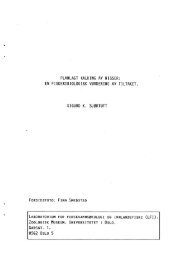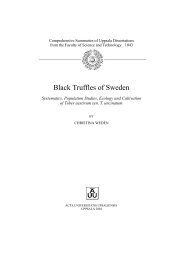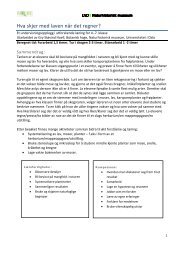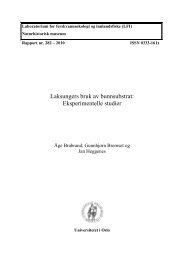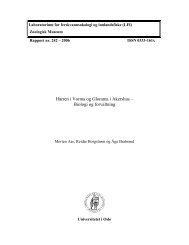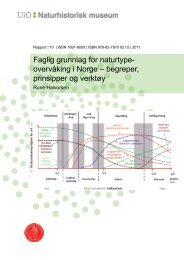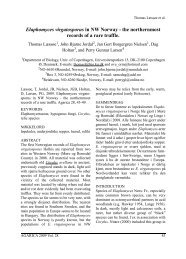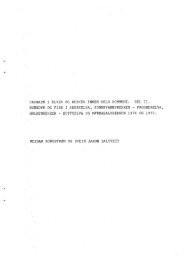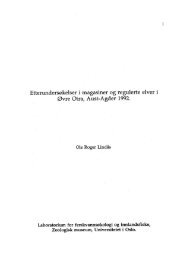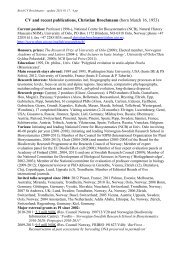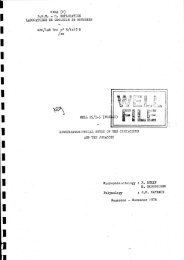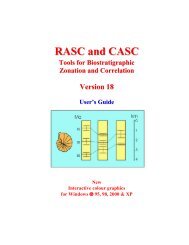Truffle trouble: what happened to the Tuberales?
Truffle trouble: what happened to the Tuberales?
Truffle trouble: what happened to the Tuberales?
- TAGS
- truffle
- www.nhm.uio.no
You also want an ePaper? Increase the reach of your titles
YUMPU automatically turns print PDFs into web optimized ePapers that Google loves.
What <strong>happened</strong> <strong>to</strong> <strong>the</strong> <strong>Tuberales</strong>? 1083<br />
<strong>the</strong> family, e.g. Sphaerosoma and Ruhlandiella (as Muciturbo) (e.g.<br />
Castellano et al. 2004). See Figs 2 and 5A-D.<br />
Pezizaceae Dumort. 1829 (syn. Terfeziaceae E. Fisch. 1897)<br />
The family Terfeziaceae as defined by Zhang (1992a, 1992b)<br />
are included in this family, but was accepted in <strong>the</strong> latest<br />
Dictionary of <strong>the</strong> Fungi (Kirk et al. 2001). Recent molecular results<br />
(e.g. Norman & Egger 1999; Hansen et al. 2005) clearly demonstrate<br />
it should be relegated <strong>to</strong> synonymy of <strong>the</strong> Pezizaceae (see<br />
review in Hansen & Trappe 2002). Thirteen out of 25 genera in<br />
<strong>the</strong> Pezizaceae (Eriksson 2006a) are exclusively truffle or trufflelike<br />
taxa, but several truffle species have also been described<br />
in Peziza. Hansen et al. (2001) gave a review of <strong>the</strong> genera.<br />
The genus Peziza was found <strong>to</strong> be non-monophyletic and all<br />
o<strong>the</strong>r pezizaceous genera nested within it (Hansen et al.<br />
2001, 2005), and a revised generic arrangement is under way<br />
(Hansen & Pfister, in preparation.). Two lineages discovered<br />
comprise most of <strong>the</strong> Peziza species, <strong>the</strong> Peziza s. str. and <strong>the</strong><br />
P. depressa–Ruhlandiella lineages, <strong>the</strong> latter including several<br />
truffles (Cazia, Peziza ellipsospora, P. whitei, Ruhlandiella, Terfezia<br />
and Tirmania; Fig 2). The P. depressa–Ruhlandiella lineage was<br />
highly supported in combined analyses of LSU, b-tubulin,<br />
and RPB2 (Hansen et al. 2005). Only one truffle genus, Mattirolomyces,<br />
clusters in Peziza s. str. in MP analyses, but without<br />
support (Fig 2). Three types of hypogeous ascomata exist<br />
within <strong>the</strong> family (Fig 2). The Amylascus–Pachyphloeus and<br />
<strong>the</strong> P. depressa–Ruhlandiella lineages produce both ptycho<strong>the</strong>cia<br />
and stereo<strong>the</strong>cia. The cardinal feature of Pezizaceae, <strong>the</strong><br />
amyloid reaction of <strong>the</strong> ascus wall, has been lost in several<br />
of <strong>the</strong> hypogeous taxa (e.g. Cazia and Terfezia).<br />
Amylascus Trappe 1971<br />
Type: Amylacus herbertianus.<br />
The type species of Amylacus has not been sampled for molecular<br />
phylogenetic study, but <strong>the</strong> genus is most likely monophyletic<br />
[A. tasmanicus has even been considered a synonym<br />
of A. herbertianus (Bea<strong>to</strong>n & Weste 1982)] and is suggested <strong>to</strong><br />
be closely related <strong>to</strong> Scabropezia and Pachyphloeus. Amylascus<br />
was originally placed in <strong>the</strong> Terfeziaceae or Geneaceae (Trappe<br />
1971, 1975a), but later, based on <strong>the</strong> thick-walled, amyloid<br />
asci, was placed in <strong>the</strong> Pezizaceae (Trappe 1979). Trappe<br />
(1975a) and Bea<strong>to</strong>n & Weste (1982) monographed <strong>the</strong> genus.<br />
Amylascus includes only <strong>the</strong> two mentioned species, both<br />
recorded only in Australia.<br />
Cazia Trappe 1989<br />
Type: Cazia flexiascus.<br />
Originally, and at times by some subsequent authors,<br />
placed in <strong>the</strong> Helvellaceae (Trappe 1989), but Kirk et al. (2001)<br />
place it in <strong>the</strong> Terfeziaceae. O’Donnell et al. (1997) were <strong>the</strong> first<br />
<strong>to</strong> place Cazia in <strong>the</strong> Pezizaceae. As can be seen from Fig 2, itis<br />
nested within <strong>the</strong> P. depressa–Ruhlandiella lineage containing<br />
both epigeous and hypogeous taxa. Cazia quercicola Fogel &<br />
States (2002) is only <strong>the</strong> second recognized species.<br />
Eremiomyces Trappe & Kagan-Zur 2005<br />
Type: Eremiomyces echinulatus (syn. Choiromyces echinulatus).<br />
Ferdman et al. (2005) found this species <strong>to</strong> cluster within <strong>the</strong><br />
Pezizaceae (with Terfezia and Tirmania species) and not with <strong>the</strong><br />
type of Choiromyces, which has affinities with <strong>the</strong> Tuberaceae.<br />
Fig 5 – Fruiting body forms in lineage A (Pezizaceae). (A-B) Sarcosphaera coronaria (A) Closed apo<strong>the</strong>cia, JHP-95.074 (C). (B) Open<br />
apo<strong>the</strong>cia. (C) Hydnobolites cerebriformis, ptycho<strong>the</strong>cia. (D) Terfezia lep<strong>to</strong>derma, stereo<strong>the</strong>cia. Pho<strong>to</strong>s: J.H. Petersen (A),<br />
K. Hansen (B), J. Nitare (C), J. San<strong>to</strong>s (D).



